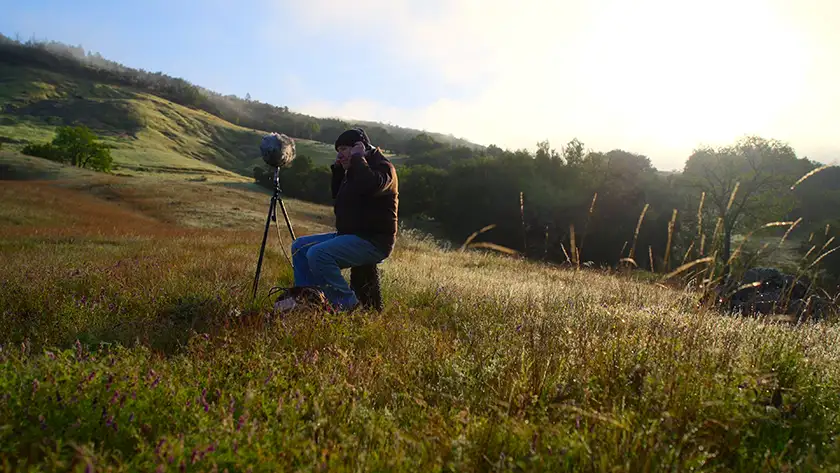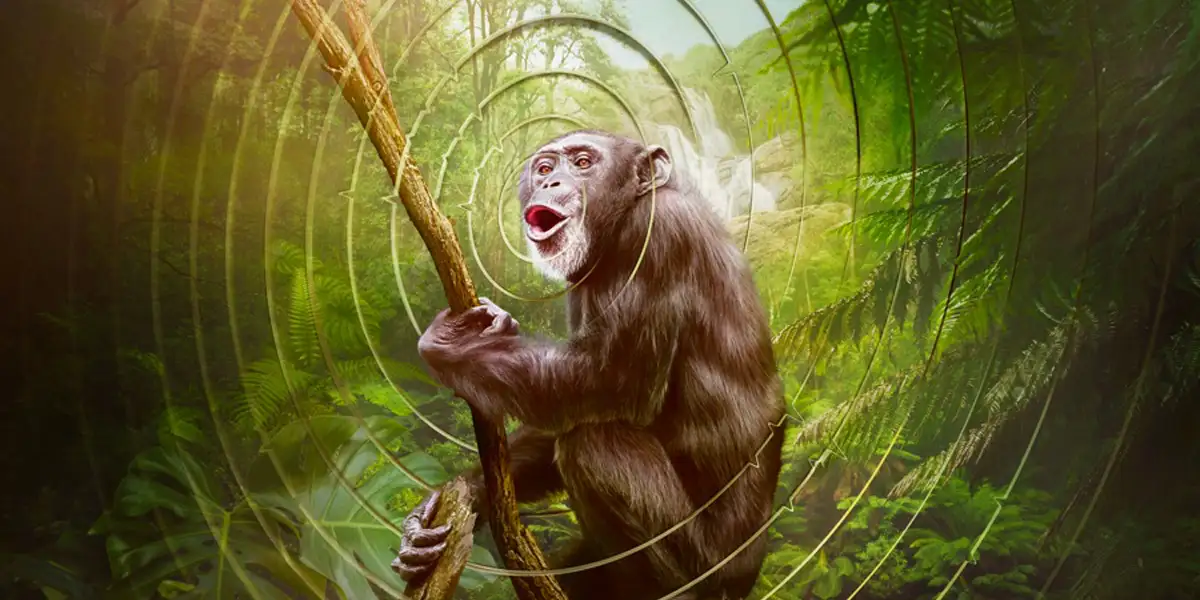In this interview, the minds behind Apple TV+’s Earthsounds talk to us about series production and the uses, results, and risks of high-tech sonic technology.
Apple TV+’s latest nature documentary series Earthsounds is the streaming giant’s coolest nature series to date, and if you haven’t watched it yet, you should absolutely make the time to check it out. Earthsounds is a 12-part natural history documentary series that uses cutting-edge technology to reveal the unexpected, unfamiliar, and untold stories of how animals, insects, and critters use, detect, and are affected by sound in the natural world. It also explores the acoustics of Earth’s landscapes and atmospheres in a most mesmerizing way.
The minds behind Earthsounds – some of whom speak to us in this interview – spent over three years capturing sounds of the natural world across seven continents with high-quality technology. While scientists captured incredible audio from habitats like the Antarctic ice shelf, tropical coral reefs, the Queensland rainforest, and the Namibian dunes, to name a few, their recordings didn’t just hip us to rarely heard soundscapes and wildlife communication techniques, they also told a much bigger story of how climate change is affecting our planet and endangering its wildlife. However, thanks to the ingenious nature of Earthsounds team, scientists have discovered how to use sound in revolutionary ways to help save our wildest places and their endangered species.
Everything about Earthsounds is stunning and mesmerizing, but it’s important to note that absolutely none of it would have been made possible or even brought to us without the remarkable minds behind Earthsounds, like its producers and scientists. We had the exciting opportunity to sit down with Producer Sam Hodges, Marine Biologist Beth Goodwin, and High-Tech Conservationist and Rainforest Connection CEO Bourhan Yassin to talk production, sonic technology, and the ways in which their efforts have provided vital clues to helping us understand and protect Earth’s wildlife, habitats, and landscapes so we can better preserve the richness of nature’s soundscapes. Read the interview below!
Producer Sam Hodges on the development and production of Earthsounds
Congratulations on such an outstanding documentary series! I think it’s the coolest nature documentary out there for multiple reasons, but mostly because of how you and the Earthsounds team explore the uses and functions of sound in the natural world. Would you talk to us about series production and technology?
Sam Hodges: The concept for Earthsounds came about when we, at Offspring Films, worked with Apple TV+ on a series called Earth at Night in Color. There, we used new, low-light cameras to shine a light on nocturnal animals in a way that we had never seen before. In a similar way, with Earthsounds we wanted to use the latest microphone technology and also processing technology to be able to hear the planet in ways we’ve never been able to hear before, which means sounds too high for us to hear, sounds too low for us to hear, tiny, sort of intimate sounds like termite footsteps. The technology was there to allow us to eavesdrop on these worlds for the first time, and that’s something we were really keen to do.
The episodes take you on acoustic journeys through the rainforests, the Pacific Ocean, and the African deserts. But something that was really important to us was also looking at how we can use sound to offer solutions to things like climate change and protecting endangered species. The “Listening to Our Planet” episode of Earthsounds is all about coming up with solutions and how we can use sound to protect our planet. I think this is probably the most fascinating program to work on, especially with people like Beth and Bourhan, who just come up with brilliant ways to eavesdrop on the planet but use that for really good, amazing purposes.

Earthsounds teams spent over 1,000 days across three-and-a-half years capturing worldwide data with sonic technology. How do you even begin to peel through thousands of hours of recordings to find what you’ll use?
S. H.: It just involved a lot of logging and organization, and we had a brilliant sound logger. He spent months going through thousands of hours of recordings, and sometimes it was finding a few seconds of vocalizations in hours of recordings. Beth sort of likened it to panning for gold: Every now and then, she would strike gold and find an amazing little clip. And quite often, these sounds had never been heard before or recorded before—the echolocation of hippos in Botswana or the tiny, sort of intricate sounds of a spider on its web.
From the series point of view, there were lots of very organized people who managed to document all the recordings, so that when we got into the edits, we knew exactly what our best recordings were and which ones we needed for each bit of the story. So, it was diligence and a very organized team.
Marine Biologist Beth Goodwin on sonic technology and stumbling across a groundbreaking Earthsounds discovery
Beth, congratulations on your groundbreaking discovery regarding humpback whales. Would you talk to us about your mission and your sonic technology, as well as what you stumbled across in your recordings?
Beth Goodwin: We were actually using the Wave Glider, or an autonomous robotic vehicle that we equipped with a hydrophone to send it out through the Pacific Ocean 5,000 miles roundtrip to search for humpback whales, which have a very loud, low frequency song [to monitor their migration between Mexico and Hawaii]. But humpback whales had never been documented in the area where we sent our Wave Glider “Europa,” because it’s at lower latitudes. So, we just took a chance and said, “Why not? Let’s just go see if they’re maybe there. Chances are, they’re not there.”
The Wave Glider picks up audio within five or 10 miles of a humpback whale … so you’re traveling in the vast, deep ocean basin thousands of miles. And then, you’re hoping that, out of nowhere, a whale intersects this tiny little surfboard that’s about ten feet long by two feet wide within five miles, to pick up a humpback whale song. We were literally looking for a needle in a haystack and weren’t thinking we’d get anything. Instead, we heard a lot of humpback whales … and it was really astonishing to hear them. We now know that there may be something going on out in the middle of the ocean at lower latitudes than anyone ever thought before.
Let’s talk more about Europa. What are some of the risks associated with launching, exploring, and recovery?
B. G.: So, launching and recovery, as you can see on the “Listening to Our Planet” episode, it’s out there all by itself. We had a camera on it where we were taking pictures all day long, to show what it’s like to do this voyage all by itself. But there are ships that could hit it. We had to go through the Great White Shark Café and I was just petrified that a shark, which is two times the size of this Wave Glider, would just bite it in half or bite the tether and hydrophone off. But amazingly, we’ve done four missions and Europa was never attacked … and never hit by a ship.
The Wave Glider has a vessel avoidance algorithm in it, so a vessel that has that has an Automatic Identification System. It will detour and start running in the opposite direction until the ship passes, and then it’ll get back on course and keep going. It’s quite a sophisticated piece of equipment.

 loudandclearreviews.com
loudandclearreviews.comHigh-Tech conservationist and Rainforest Connection CEO Bourhan Yassin talks bioacoustics and his technology monitoring capabilities
Bourhan, your company builds and deploys scalable open acoustic monitoring systems to enable biodiversity measurement and monitoring. But that’s not all. Would you talk to us about bioacoustics and how your high-tech sound recorders, known as Guardians, are used?
Bourhan Yassin: Yeah, definitely! The science of bioacoustics [or the study of species through sound] is not new by any means; it’s decades old and has been used in the past in many aspects. I think the great thing about the Guardians is their ability to monitor a much larger area. As you saw [in episode 12], we climb up those trees and install them on top of the tree canopy. It gives a really good capability of capturing the most amount of sound, as sound travels up. And then they’re also right there where they can capture sunlight. It puts the Guardian in the best place to get powered and to get connectivity.
And how do Guardian work to identify and conserve rainforest habitats and their inhabitants?
B. Y.: Each Guardian has onboard A.I. that’s able to analyze all the audio that’s coming in in real time. It can detect all these sounds simultaneously and then send it to the Cloud, or even alert people on the ground to illegal activity [like logging and poaching]. I think that’s the part that made the Guardians so unique in the field of bioacoustics. It was great to be able to demo that and show the whole process end to end. It was really a lot of fun.
There are 900 sites around the island [of Puerto Rico] where these Guardians are collecting data, and the project is actually public: You can go to Rainforest Connection and see all the recordings and information. But today, there are 9.4 million recordings uploaded to the Cloud—each a one-minute recording—so there are nine-and-a-half million minutes of soundscape audio. The possibility of a human trying to go through that would take ages, which is why the A.I. sifts through that and detects the species for us in real time.
That’s how we provided Earthsounds with some examples of these recordings: by being able to filter down to a particular species. You saw [in episode 12] the Puerto Rican parrot, one of the super rare, endangered species we were also looking to protect. It’s, I think, a 20-year-long rehabilitation project by the U.S. Fish and Wildlife Service. And just now, they’re starting to release it back into the wild. So, seeing one parrot or even hearing one vocalize is quite a unique experience, and that was part of what was recorded as well.
We send a huge thank you to you creative minds behind Earthsounds for talking to us! We anxiously await your next sound-in-nature documentary masterpiece!
This interview was edited for length and clarity.
Header photos: Bourhan Yassin installing microphones in Puerto Rican forests to perform acoustic analysis on Puerto Rican parrots in Episode 12 of Earthsounds / poster for the series / a photo of Marine Biologist Dr. Beth Goodwin, subject of Episode 12 of Earthsounds (Courtesy of Apple TV+)
Earthsounds is now available to watch on Apple TV+. Stream Earthsounds and read our review of Earthsounds!
Loud and Clear Reviews has an affiliate partnership with Apple, so we receive a share of the revenue from your purchase or streaming of the films when you click on the button on this page. This won’t affect how much you pay for them and helps us keep the site free for everyone.

